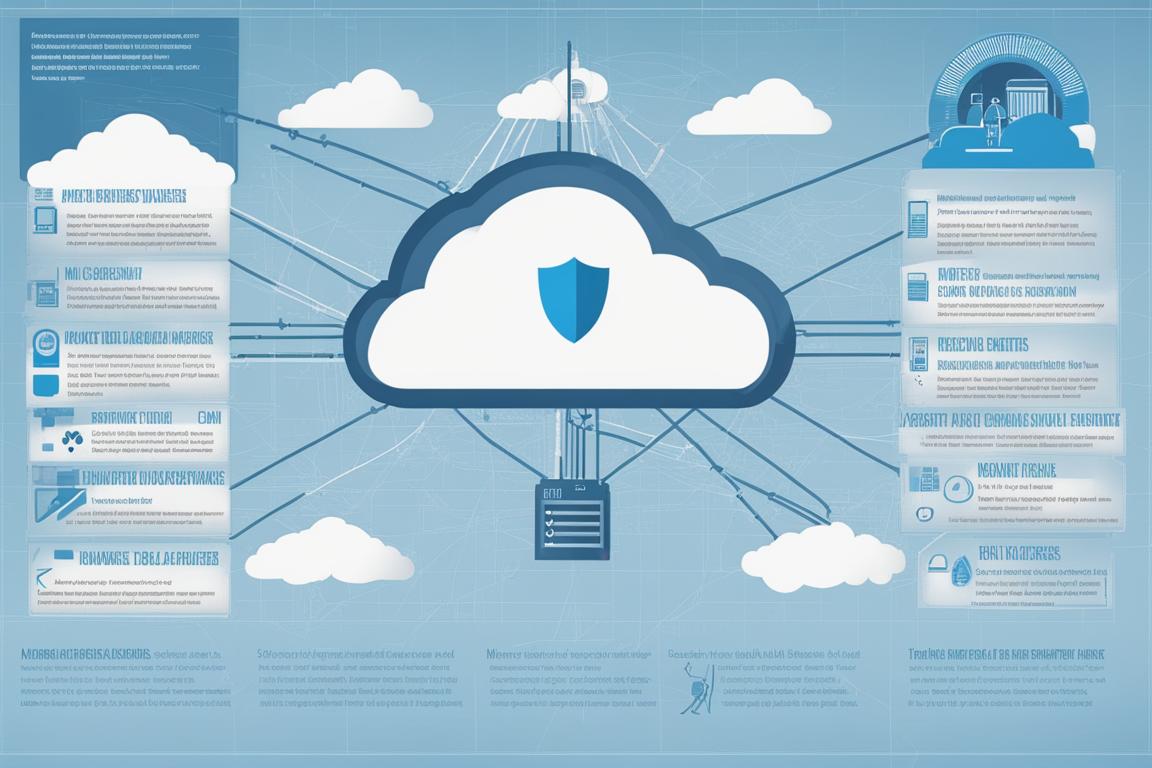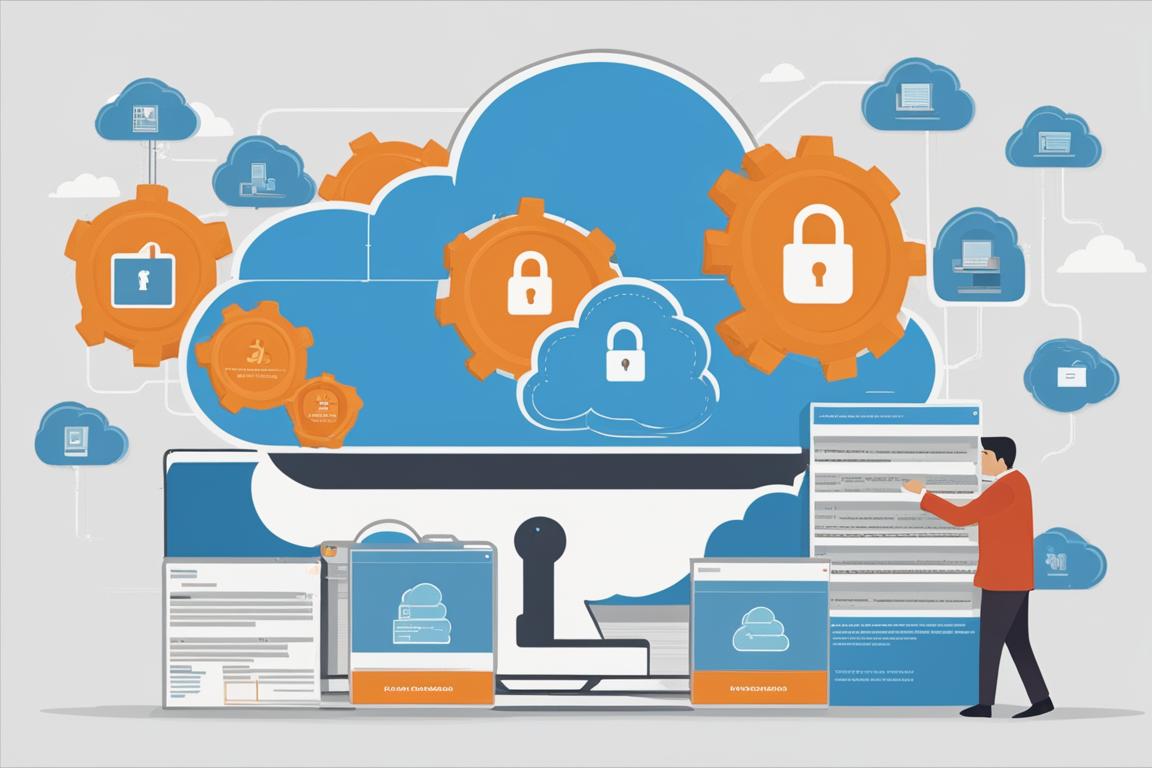Securing the cloud isn’t just a technical obligation; it’s a fundamental necessity in today’s digital era. As we continue to surge forward, integrating cloud computing into the very fabric of our businesses and personal lives, the conversation around cloud security has evolved from a whisper in IT corridors to a boardroom imperative. The narrative is no longer about whether to adopt cloud technology but how to do so securely, ensuring that your digital assets, from data to applications, are protected against the increasingly sophisticated cyber threats of the 21st century.
Learn about Securing the Cloud
- How to secure your cloud journey?
- How to protect cloud workloads, applications, and data?
- What are common cloud security products and services?
Cloud Security
Secure Your Cloud Journey
Embarking on a cloud journey is akin to setting sail in uncharted waters. The potential rewards are vast, but so are the risks. My personal experience transitioning a mid-size enterprise’s entire data infrastructure to the cloud was a rollercoaster that taught me invaluable lessons about the importance of a robust security framework from the get-go. It’s not just about lifting and shifting your existing processes to a cloud environment; it’s about reimagining what security means in a space where the boundaries of your network are as fluid as the cloud itself.
A comprehensive cloud security strategy must be proactive rather than reactive, integrating security considerations into the very architecture of your cloud setup. This involves employing a multi-layered security approach that encompasses everything from access control and threat detection to data encryption and incident response. The goal is to create a cloud environment where security is not an afterthought but a foundational component of your infrastructure.

Protect Your Cloud Workloads
Cloud workloads, by their very nature, are dynamic and scalable, attributes that can also make them vulnerable if not adequately protected. The adoption of container technologies and microservices has further complicated the security landscape, introducing new challenges in visibility and control. Protecting your cloud workloads requires a deep understanding of your cloud architecture and the implementation of strict access controls, network security policies, and continuous monitoring.
One of the most effective strategies I’ve employed is the segmentation of workloads into secure zones. By isolating different workloads from each other, you can limit the potential impact of a breach, making it easier to contain and resolve. Coupled with real-time threat intelligence and automated security policies, this approach can significantly enhance the security of your cloud workloads.
Secure Your Cloud Applications
In the era of cloud computing, applications are often the primary interface through which users interact with your digital assets. This makes them a prime target for attackers looking to exploit vulnerabilities for data theft or malicious activities. Securing your cloud applications requires a multifaceted approach that includes regular vulnerability assessments, the implementation of secure coding practices, and the adoption of application security technologies such as web application firewalls (WAFs) and secure application service edges (SASE).
My journey in securing cloud applications has taught me the critical importance of incorporating security into the development lifecycle from the very beginning. This means embedding security considerations into the design, testing, and deployment phases, a practice often referred to as DevSecOps. By making security an integral part of the development process, you can ensure that your cloud applications are resilient to attacks from their inception.
Secure Your Cloud Data
The value of data has never been higher, nor the consequences of its breach more severe. Data security in the cloud encompasses a broad spectrum of practices, from encryption and tokenization to access controls and data loss prevention (DLP) measures. The challenge lies not only in securing the data itself but also in ensuring the privacy and compliance of data across jurisdictions, a task that has become increasingly complex in the face of evolving regulatory landscapes.
In my experience, a data-centric approach to cloud security is paramount. This involves classifying data based on sensitivity and applying appropriate security controls accordingly. Encryption, both at rest and in transit, should be a default, coupled with stringent access management and monitoring to ensure that only authorized users can access sensitive information.
Secure Your Multi-Cloud Environment
The shift towards multi-cloud environments has brought about a host of new security challenges, chief among them being the complexity of managing disparate security policies and controls across multiple cloud platforms. The key to securing a multi-cloud environment lies in the adoption of a unified security management platform that offers visibility and control across all your cloud assets.
My adventures in navigating the multi-cloud landscape have underscored the importance of consistency in security policies and the centralization of security management. By leveraging cloud security posture management (CSPM) tools, you can automate the detection and remediation of security risks, ensuring a consistent security posture across your entire multi-cloud environment.
Real-Life Scenario: Importance of Cloud Security Posture Management
As a cybersecurity consultant, I recently worked with a company that had migrated its operations to the cloud without a proper security posture in place. The lack of centralized visibility and control over their cloud environment left them vulnerable to various threats.
Case Study: John, the IT manager, noticed unusual activity on the company’s cloud servers. Without a Cloud Security Posture Management (CSPM) solution in place, they struggled to identify the root cause of the issue. After a thorough security assessment, we found misconfigured storage buckets that exposed sensitive customer data. Implementing a CSPM solution helped them continuously monitor and enforce security policies, preventing future misconfigurations and unauthorized access.
This real-life scenario highlights the critical role of Cloud Security Posture Management in securing cloud environments effectively. By proactively managing security configurations, organizations can mitigate risks and ensure compliance across their cloud infrastructure.
Cloud Security Products and Services
Cloud Security Posture Management
Cloud Security Posture Management (CSPM) tools are indispensable in the quest for cloud security. They offer a panoramic view of your cloud ecosystem, identifying misconfigurations, compliance violations, and potential security threats. My reliance on CSPM tools has been a game-changer, allowing me to proactively address vulnerabilities before they can be exploited by attackers.
The beauty of CSPM lies in its ability to automate the continuous assessment of your cloud security posture, freeing up valuable resources to focus on strategic security initiatives. By integrating CSPM into your cloud security strategy, you can achieve a level of visibility and control that is critical in today’s complex cloud environments.
Cloud Workload Protection Platforms
Protecting cloud workloads in a dynamic, scalable environment requires a solution that can adapt as quickly as the workloads themselves. Cloud Workload Protection Platforms (CWPP) are designed to secure workloads across any environment, providing real-time threat detection, vulnerability management, and network security. My adoption of CWPP has significantly enhanced the security of my cloud workloads, enabling me to detect and respond to threats with unprecedented speed and efficiency.

Cloud Access Security Brokers
Cloud Access Security Brokers (CASBs) have emerged as critical tools in securing cloud applications and services. They act as intermediaries between users and cloud service providers, enforcing security policies and providing visibility into cloud usage. My experience with CASBs has been transformative, allowing me to extend my security controls beyond the traditional perimeter and into the cloud.
CASBs are particularly effective in managing the security of SaaS applications, offering capabilities such as encryption, access control, and threat prevention. Their ability to provide granular visibility into cloud activities makes them an essential component of any cloud security strategy.
Secure Web Gateway
The Secure Web Gateway (SWG) serves as the guardian of your internet access, filtering unwanted software/malware from user-initiated web/internet traffic and enforcing corporate and regulatory policy compliance. In my journey, SWGs have been pivotal in preventing web-based threats from penetrating our cloud environment, providing an additional layer of security that complements our existing defenses.
By integrating SWG with other cloud security solutions, such as CASBs and CWPPs, you can create a comprehensive security framework that protects against a wide range of cloud and web-based threats.
Data Loss Prevention
Data Loss Prevention (DLP) technologies play a crucial role in protecting sensitive information from unauthorized access or exfiltration. My implementation of DLP solutions has been instrumental in ensuring that our data remains secure, regardless of where it resides within the cloud ecosystem. DLP solutions offer deep visibility into data movement and usage, enabling you to enforce policies that prevent sensitive data from falling into the wrong hands.
In a cloud environment, DLP becomes even more critical, as the boundaries of your network extend beyond the physical premises. By incorporating DLP into your cloud security strategy, you can safeguard your most valuable assetsyour data.
Secure Email Gateway
Email remains one of the most significant vectors for cyberattacks, making the Secure Email Gateway (SEG) an essential component of cloud security. SEGs protect against phishing, malware, and other email-borne threats, ensuring that malicious content is identified and quarantined before it can cause harm. My reliance on SEGs has significantly reduced the risk of email-based attacks, providing a robust defense against one of the most common threats to our cloud environment.
Cloud Security Services
Cloud security services encompass a broad range of offerings designed to enhance the security of cloud environments. From managed security services that offload the burden of security management to specialized consulting services that provide expert guidance on complex security challenges, these services can be a valuable addition to your cloud security arsenal.
My engagement with cloud security services has been transformative, providing access to expertise and resources that have significantly enhanced our security posture. By partnering with the right cloud security service provider, you can leverage specialized knowledge and technologies to secure your cloud journey effectively.
In conclusion, securing the cloud is a dynamic and continuous process that requires a strategic approach, leveraging the right mix of technologies, policies, and practices. My journey through the complexities of cloud security has taught me that while the challenges are significant, they are not insurmountable. With the right mindset and tools, you can protect your cloud workloads, data, and applications against the evolving threats of the digital age. Remember, in the realm of cloud security, complacency is the enemy. Stay vigilant, stay informed, and most importantly, stay secure.
Q & A
Who should be responsible for securing the cloud in a company?
The IT department or a dedicated cloud security team typically handles cloud security.
What are some common methods for securing the cloud?
Common methods include encryption, access controls, multi-factor authentication, and regular security audits.
How can businesses ensure data protection when using cloud services?
Businesses can ensure data protection by implementing strong encryption, access controls, and regular security monitoring.
What is the biggest objection to investing in cloud security measures?
The biggest objection is often the perceived cost of implementing and maintaining robust cloud security measures.
How can small businesses with limited resources improve cloud security?
Small businesses can improve cloud security by utilizing cost-effective security tools, training employees on security best practices, and implementing strong password policies.
What role does employee training play in enhancing cloud security?
Employee training is crucial for enhancing cloud security as it helps in creating a security-conscious culture and preventing common human errors that can lead to security breaches.
With a Ph.D. in Cybersecurity and over a decade of experience in cloud security research, our author is a recognized expert in the field. They have published numerous articles in reputable journals such as the Journal of Cloud Security and have presented their findings at international conferences on cybersecurity. Their research has focused on the vulnerabilities of cloud environments and effective strategies for securing cloud workloads and applications. Additionally, they have worked closely with various organizations to develop and implement cloud security solutions, giving them a practical understanding of the challenges businesses face in securing their cloud infrastructure. By combining their academic expertise with real-world experience, our author provides valuable insights into cloud security practices and the importance of maintaining a strong security posture in the cloud.
